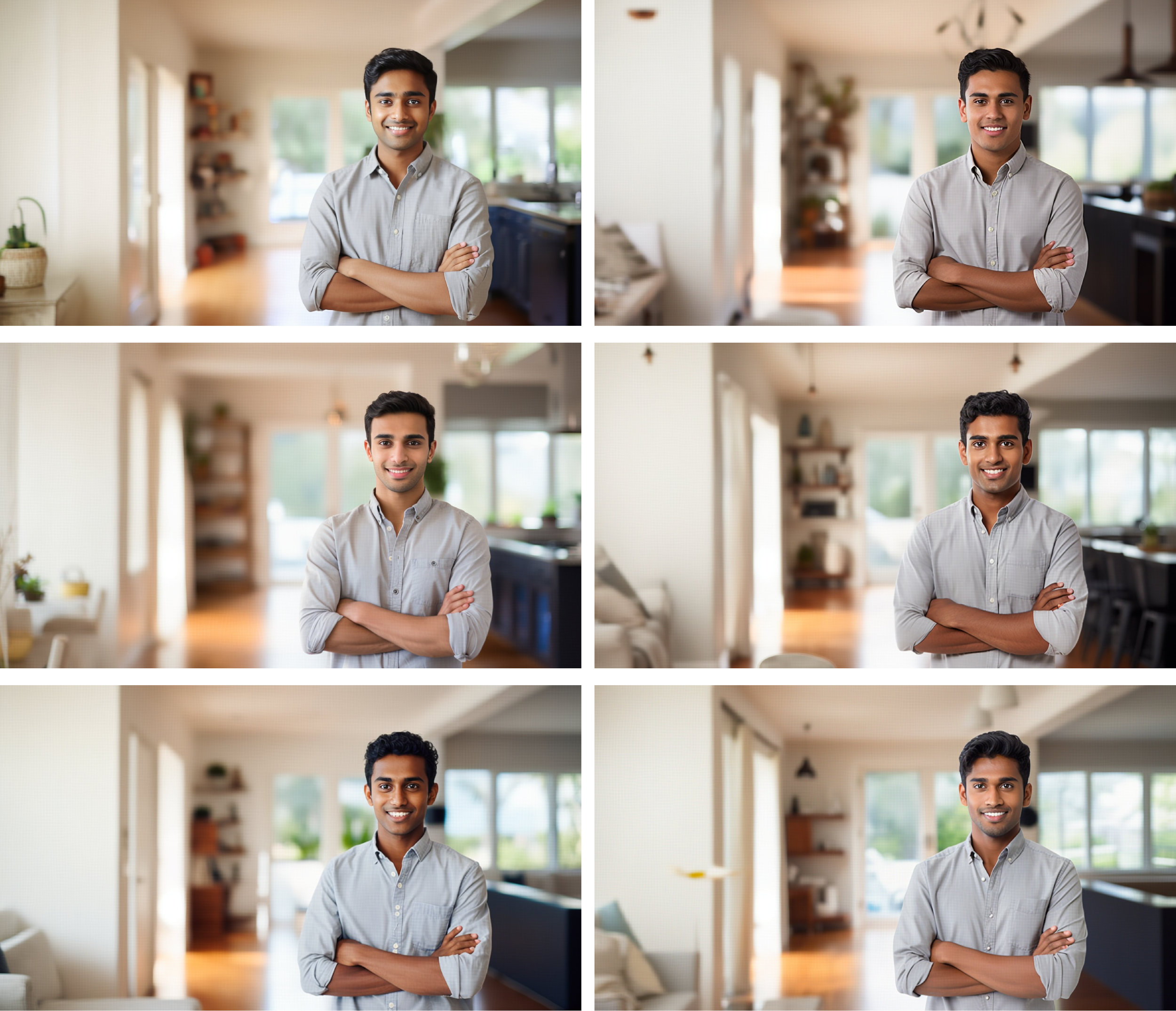Reach Every Customer With Generative AI
Segmentation grids created in Midjourney
This is a reprinted article from my LinkedIn account. I’ll publishing articles in parallel between this site and LinkedIn.
Update:
August 17, 2023
Since I published this article back in February, there have been several updates to Midjourney. I decided to go back and update the imagery to be a more current representation of what the technology can achieve.
What Is Generative AI?
Generative AI uses AI algorithms to generate new data based on existing patterns, with applications in digital art, music, images, text, and product design. It aims to make content creation faster, more efficient, and accessible. For businesses, it offers immense potential and can transform various industries.
In marketing, generative AI has the potential to revolutionize the way companies approach and execute their strategies. The technology presents opportunities and challenges that must be considered, but its applications in marketing make it a cutting-edge tool for businesses.
Using Image Synthesis to Optimize Marketing Tasks
Image synthesis generates realistic images using AI algorithms and can optimize marketing by streamlining the creation of high-quality images. This technology can save time and resources for product visualization, social media posts, advertisements, and other marketing materials. It also enables marketers to test and optimize creative concepts for maximum impact.
The article primarily focuses on my examination of market segmentation through image generation experiments. Future articles will examine the use of ChatGPT for copy personalization as well as AI art and copy for creating marketing campaigns.
Automation
Automation is one of the primary uses of generative AI. It can automate a wide range of tasks, including writing reports, creating presentations, generating product descriptions, and much more. The ability to automate these time-consuming and repetitive tasks allows companies to save time and resources while also increasing efficiency.
Personalization
Another important use of generative AI is personalization. With its ability to analyze large amounts of data and generate unique content, generative AI can help companies personalize their offerings for individual customers. For example, it can be used to generate personalized email campaigns, product recommendations, or even custom advertisements. This level of personalization allows companies to build stronger relationships with their customers and improve their overall experience.
Segmentation Experiments
The bulk of this article documents a comprehensive series of experiments I ran using Midjourney's remix function to generate variations on a base image, based on certain demographic traits.
Why did I do this?
The large quantity and diverse range of images required for this set of experiments would be unfeasible to capture through photography and excessively expensive to obtain from conventional stock image providers.
Furthermore, the cost of hiring models, photographers, and any necessary equipment and props would also add to the already prohibitive cost of obtaining the necessary imagery through traditional means.
Meet Customers Where They Are
As mentioned above, AI-assisted automation enables the generation of diverse, high-quality creative assets at scale and with precise targeting. This leads to more effective, targeted acquisition events.
Representation Matters
One principal advantage of a highly granular level of segmentation lies in the ability to reach under-served and under-represented customer cohorts with precision. By targeting these specific groups, we can establish a stronger connection with potential customers and optimize their experience. This results in a personalized approach that caters to the unique needs of these customers.
Base Image
Base Image
The base prompt was: Indian man age 20, wearing a button-up shirt, arms crossed, slight smile, looking at camera, camera right, typical American suburban open concept living room background out of focus.
Segmentation by Age and Gender
Once I established my base image, I created segmentation grids. The first grid is sorted by age and gender.
Cohort segmentation by age and gender
Segmentation by Nationality/Ethnicity and Gender
With AI-assisted segmentation, precise targeting is easily achievable. This results in more cost-effective and focused campaigns, allowing businesses to reach specific customer groups more effectively. This includes targeting across an entire range of ethnicities and nationalities.
Segmentation by broad ethnic/national characteristics
Segmentation by Subnational Characteristics
It's important to note that while general terms such as "Asian" can provide a broad understanding, it is crucial to target specific regions within that group as they can have significant differences. This level of specificity will become necessary in the future of AI-assisted marketing.
Indian cohort segmentation by regional ethnicity
Post-colonial regions often exhibit a diverse range of physical characteristics within their population, with Puerto Rico being a noteworthy example. In such regions there may also be a history of colorist prejudice, thus it becomes all the more crucial to engage a diverse group of individuals.
Puerto Rican cohort segmentation by ethnic heritage
Segmentation by Education and Income
These outputs are arranged based on estimated levels of education and income. With the improvement of AI models' accuracy, it will be possible to obtain more detailed information about traits such as specific employers (e.g. Walmart, Target), region (e.g. Northern California versus Southern California), etc. beyond just education and income.
Segmentation grid organized around income, education, and employment
Image Variety
In a real campaign situation we probably wouldn't repeat setups as precisely as I did for this series of experiments. This was meant to be a capabilities exercise. I think people might find a set of clones like I've shown above to be eerie, and probably uncanny. A real set of campaign imagery would likely appear more like this:
Segmentation grid with maximum visual variations
That said, one paramount advantage of generative image synthesis for market segmentation is the ability to create virtually infinite iterations on a theme, while also providing a completely granular level of visual control.
Caveats
Currently, generative image AI still has several limitations that prevent it from producing fully market-ready results. These include:
Lack of Photorealism: Generated images can look artificial and lack the intricate details and complexities of real-life photos, although this is getting significantly better every day.
Character Stability: Generated images may also lack consistency in terms of the appearance and behavior of characters, leading to issues with character stability.
Clothing Stability: Similar to character stability, generated images may also have issues with clothing consistency, stability, and appearance.
Background Stability: Generated images may also have background-related stability issues, such as incorrect or inconsistent environments and settings.
Rendering Errors: Generated images may also have issues with unnatural appearances, such as extra fingers or body parts.
Perils and Pitfalls
Too much personalization?
Some people may find the use of generative AI for automation and hyper-specific personalization to be creepy. This is because AI models can collect, analyze and use large amounts of personal data, which can be seen as intrusive or threatening to privacy.
Bias
Additionally, if not designed and used ethically, AI systems can perpetuate and amplify biases, causing unfair treatment of certain groups. Furthermore, the accuracy and reliability of AI systems can also be questionable, leading to errors and consequences that can be difficult to predict or mitigate.
Ethics
It is important for organizations to consider the potential risks and ethical implications of using AI, and to implement measures to ensure that the technology is used in a responsible and transparent manner.
In Conclusion
Generative AI technology holds immense potential for businesses to reach every customer with precision. With its ability to transform various industries, companies that embrace this technology will reap significant benefits in the near future. Despite some limitations and potential risks, the use of generative AI can lead to more effective, targeted acquisition events and a personalized approach that caters to the unique needs of customers. That said, it's crucial for organizations to consider the potential ethical implications of using AI and implement measures to ensure responsible and transparent use of this technology.
About the Author
Arlan Smith is a creative executive with extensive experience in design-led brand and marketing creative. He began his career in entertainment, before moving into brand and marketing work for tech companies. Previously, he was the Director of Creative Services at the leading global streaming platform for Japanese Anime, Crunchyroll.
Over the last six months, Arlan has been deeply immersed in the world of generative AI, researching the capabilities and applications of this exciting and transformative technology.
You can view his AI artwork at: instagram.com/serpenticaldi
Arlan's portfolio: www.arlansmith.com








